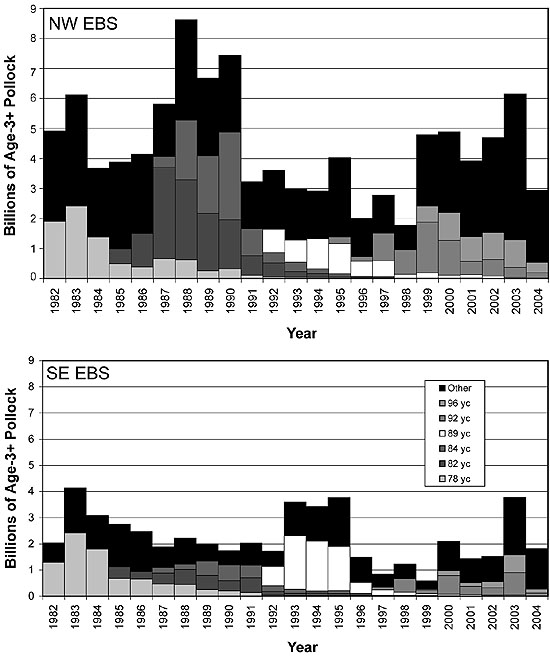Resource Ecology and Ecosystem Modeling Program
Fish Stomach Collection and Analysis
Laboratory analysis was performed on 4,519 groundfish stomachs from the eastern Bering Sea, 39 from the
Gulf of Alaska, and 74 from the Aleutian Islands region. During this quarter, no stomachs were returned
by observers, and no stomachs were collected aboard research vessels in the Bering Sea or the Gulf of
Alaska. A total of 17,746 records were added to the groundfish food habits database.
By Troy Buckley, Geoff Lang, and Mei-Sun Yang
Seabird-Fishery Interactions Research
Interactions between commercial fishing vessels and scavenging seabirds have received increasing attention
in recent years. Seabird-fishery studies in the North Pacific have focused almost exclusively on the danger
to birds of accidental entanglement in fishing gear. However, studies from other oceans, particularly the
North Atlantic, have demonstrated that fisheries discards and offal can positively affect seabird populations.
In November 2004, we launched a new project to take an ecosystem approach to seabird-fisheries interactions
in Alaskan waters. The ultimate goal is to integrate into population models for target seabird species, both
the positive and negative impacts of fisheries, and to integrate these effects across multiple fisheries. The
first step in the process is to map in time and space the availability to seabirds of fisheries discards and
offal. Future steps will link food availability to estimated population level changes. The project is supported
in part by a National Research Council post doctoral fellowship to Dr. Ann Edwards, a recent graduate of the
University of Washington, Department of Zoology.
By Shannon Fitzgerald
Spatial Distribution of Walleye Pollock in the Eastern Bering Sea
In collaboration with other AFSC scientists, Troy Buckley has been looking at spatial distribution patterns
of walleye pollock in the eastern Bering Sea (EBS). The large biomass of walleye pollock in the EBS is
supported by occasional recruitment of very large year classes. Hypotheses developed to link recruitment
variability with climate and oceanographic conditions explain only a limited portion of the variability.
Environment-recruitment relationships can be obscured by combining groups of fish with asynchronous
population trajectories.

Figure 5. The number of walleye pollock, age-3 and older, in the NW and SE regions of the EBS shelf
as found by the summer bottom trawl survey from 1982 through 2003. The contribution of large year classes
(78, 82, 84, 89, 92, and 96) in each region are indicated in each year.
We examined the distribution of year classes over time based on age-specific catch-per-unit-effort from
summer bottom trawl surveys of the EBS shelf from 1982 to 2004. The patterns in distribution of large year
classes were easiest to discern because of their large signal-to-noise ratio. The distribution of the ‘78 and
‘89 year classes exhibited a high abundance in both the northwest and southeast regions of the EBS shelf, but
the ‘82 and ‘84 year classes exhibited a high abundance only in the northwest region (Fig. 5 above). Consequently,
the total number of adult walleye pollock in the northwest and southeast regions appears to fluctuate asynchronously.
It is interesting that during the period from 1987 to 1990 when the ‘82 and ‘84 year classes were very abundant in
the northwest region, there did not appear to be any density-dependent shift into the southeast region. Recognition
of the spatial distribution of walleye pollock year classes within the EBS management area might enhance our ability
to understand the relationship between environmental factors and recruitment.
By Troy Buckley
>>>continued

|

|
Quarterly sidebar
AFSC Quarterly Research Reports Oct-Dec 2004
Contents
Feature
Items
ABL Reports
NMML Reports
RACE Reports
REFM Reports
Quarterly Index
Quarterly Home
|

